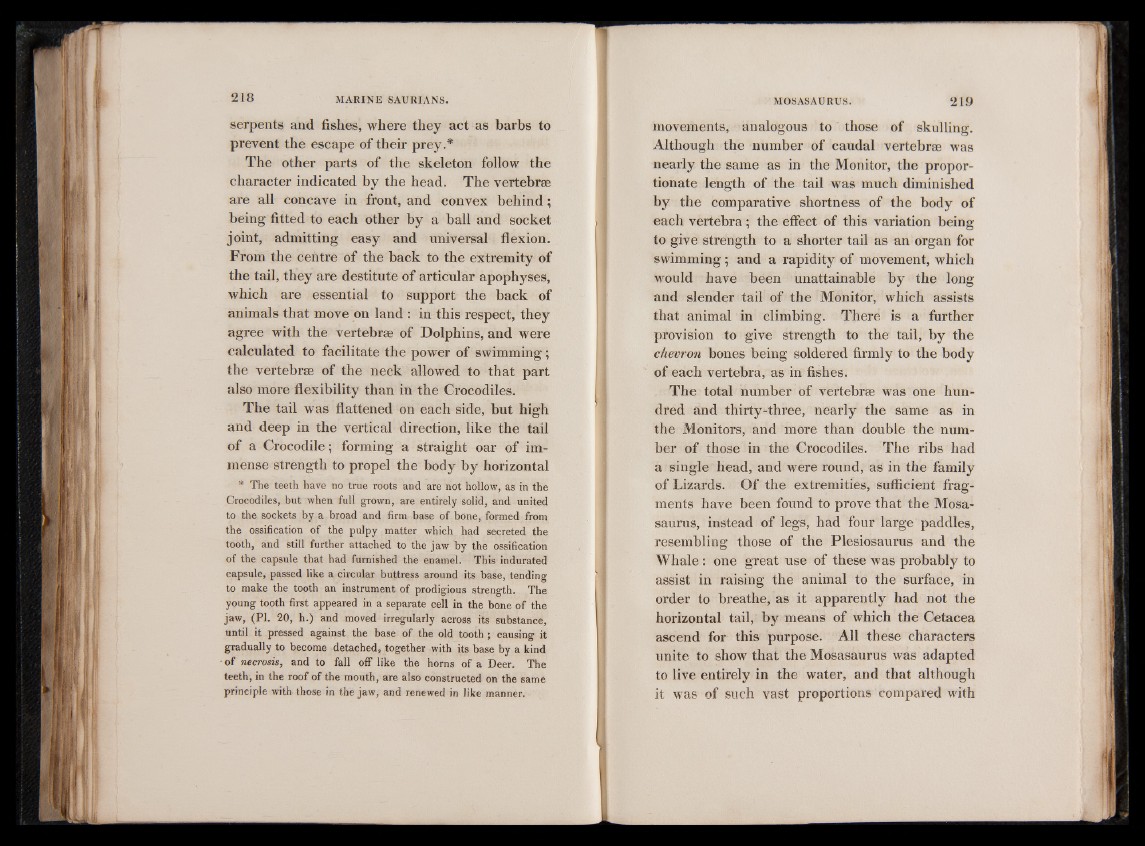
serpents and fishes, where they act as barbs to
prevent the escape of their prey.*
The other parts of the skeleton follow the
character indicated by the head. The vertebrae
are all concave in front, and convex behind;
being fitted to each other by a ball and socket
joint, admitting easy and universal flexion.
From the centre of the back to the extremity of
the tail, they are destitute of articular apophyses,
which are essential to support the back of
animals that move on land : in this respect, they
agree with the vertebrae of Dolphins, and were
calculated to facilitate the power of swimming;
the vertebrae of the neck allowed to that part
also more flexibility than in the Crocodiles.
The tail was flattened on each side, but high
and deep in the vertical direction, like the tail
of a Crocodile; forming a straight oar of immense
strength to propel the body by horizontal
* The teeth have no true roots and are not hollow, as in the
Crocodiles, but when full grown, are entirely solid, and united
to the sockets by a broad and firm base of bone, formed from
the ossification of the pulpy matter which had secreted the
tooth, and still further attached to the jaw by the ossification
of the capsule that had furnished the enamel. This indurated
capsule, passed like a circular buttress around its base, tending
to make the tooth an instrument of prodigious strength. The
young tooth first appeared in a separate cell in the bone of the
jaw, (PI. 20, h.) and moved irregularly across its substance,
until it pressed against the base of the old tooth ; causing it
gradually to become detached, together with its base by a kind
of necrosis, and to fall off like the horns of a Deer. The
teeth, in the roof of the mouth, are also constructed on the same
principle with those in the jaw, and renewed in like manner.
movements, analogous to those of skulling.
Although the number of caudal vertebrae was
nearly the same as in the Monitor, the proportionate
length of the tail was much diminished
by the comparative shortness of the body of
each vertebra; the effect of this variation being
to give strength to a shorter tail as an organ for
swimming; and a rapidity of movement, which
would have been unattainable by the long
and slender tail of the Monitor, which assists
that animal in climbing. There is a further
provision to give strength to the tail, by the
chemon bones being soldered firmly to the body
of each vertebra, as in fishes.
The total number of vertebrae was one hundred
and thirty-three, nearly the same as in
the Monitors, and more than double the number
of those in the Crocodiles. The ribs had
a single head, and were round, as in the family
of Lizards. Of the extremities, sufficient fragments
have been found to prove that the Mosasaurus,
instead of legs, had four large paddles,
resembling those of the Plesiosaurus and the
Whale: one great use of these was probably to
assist in raising the animal to the surface, in
order to breathe, as it apparently had not the
horizontal tail, by means of which the Cetacea
ascend for this purpose. All these characters
unite to show that the Mosasaurus was adapted
to live entirely in the water, and that although
it was of such vast proportions compared with